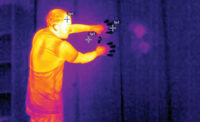
OSHA 29 CFR 1910.151 requires the availability of suitable first-aid treatment facilities in the event of a workplace injury. Specifically, the requirement states “suitable facilities for quick drenching or flushing of the eyes and body shall be provided…†In the past the definition of “suitable†was left up to the specifier. But the 2004 revision of ANSI Z358.1 provides more clarity. In order to mitigate the chance of an injured worker short-cutting the required 15-minute emergency equipment use cycle due to inordinately cold or warm water temperature, an acceptable high and low range of temperatures was established.
Outlet water temperatures within the prescribed range — at least 60°F to below 100F° — provide the victim with maximum possible comfort, while also promoting a full duration eyewash or drench shower use cycle. It’s estimated most existing industrial eyewash and shower systems do not comply with the temperature range provision of the standard. Here are four steps to bring you into compliance, and keep your company out of “hot waterâ€:
1) Determine your actual inlet water temperature. Don’t forget to check both initial and sustained temperature readings at various locations throughout the facility. Also, consider the impact of seasonal weather on water temperatures.
2) Identify needed changes. Where sustained water temperatures are outside the required range, you need to either warm or cool the supply, including provisions for re-circulation to assure prompt delivery of within-range temperatures. Consider the number of shower and eyewash locations to be included in the total system, the maximum distance between components and the likely impact of exposure to your specific ambient temperature circumstances. Manufacturers of emergency showers and eyewashes can provide insight into properly designing your entire system installation.
3) A tempered water-blending valve will be needed for systems requiring warming of sustained-use cold input water prior to emergency use. The blending valve is the “brains†of a conventional tempered water system, ensuring the emergency equipment receives water within the required temperature range.
4) Once the blending valve is identified, decide on your hot water source. For inlet water that requires cooling prior to use, this is actually your first step, because no mixing valve is needed for these applications. Remember to consider the worst case — maximum, multiple simultaneous use circumstances — when sizing heating or cooling components. Advancements in instantaneous hot water heaters have made these products practical for use in emergency equipment applications, where space for heating equipment and storage tanks is an issue. This approach also can minimize or eliminate the need for recirculation systems.
The intent in setting acceptable outlet water temperature ranges is to make accident victims as comfortable as possible, ensuring the requisite 15-minute drench or irrigation cycle protocol is followed. At the same time, you minimize your company’s exposure to non-compliance and other potential headaches.
